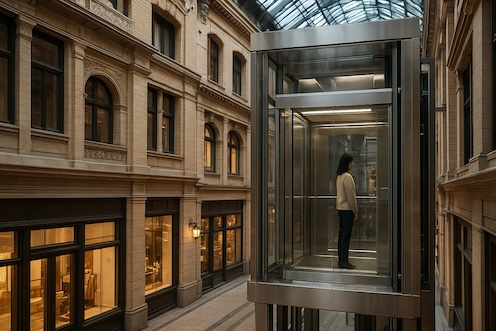In a century old commercial pedestrian street in Shanghai, a quiet transformation is taking place. The street is about 1.2 kilometers long and has 37 historically protected buildings. 80% of the shops are located on the second floor or above. With the rise of "immersive consumption", problems are gradually emerging: the turnover rate of young consumers due to "being too lazy to climb stairs" has reached 45%, and elderly customers fall an average of 23 times a year in the fitting room. Even well-known tea beverage brands were forced to terminate their contracts early due to insufficient foot traffic on the second floor.

The conflict between historical preservation and commercial logic
Ms. Chen, the director of street management, will launch the "Elevator Access" renovation plan in 2024. The initial exterior sightseeing elevator plan was opposed due to its destruction of the historical architectural style, impact on the flow of commercial traffic, and insufficient load-bearing capacity of the old building. Indoor rotary elevators occupy commercial space and are also resisted by merchants; The high electricity demand of traditional elevators leads to frequent power outages in old buildings.
Mismatch of demand revealed by data
The White Paper on Elevators in Chinese Department Stores (2023) shows that 76% of commercial building renovation elevators in China suffer from "demand mismatch" problems, including uneven distribution of passenger flow, fragmented experience, and difficulty in cost recovery. For example, the passenger flow on the second floor decreased by 18%, while the fifth floor only increased by 5%; The daily operating costs are 10 times higher than household elevators, and 78% of projects lack a traffic monetization mechanism.
Implementation of innovative solutions
Ms. Chen's team ultimately collaborated with a technology company and adopted a 'invisible vertical transportation system':
Space Fusion Technology: Maglev Track+Variable Transparent Car, Hidden in Architectural Decoration Lines;
Mobile operation thinking: Install AR fitting mirrors in elevators to intelligently recommend floors based on passenger preferences;
Energy Symbiosis System: Utilizing elevator lift gravity potential energy to generate electricity combined with photovoltaic exterior walls, achieving energy self-sufficiency and reducing energy consumption by 65%.
New consumption landmark
Nowadays, elevators have become a new landmark of consumer experience: the car releases fragrance according to the floor theme, floor projection guides customers, data is integrated into the CRM system, and exclusive discounts are pushed to old customers. Ms. Chen realized that in the era of experience economy, elevators are no longer just a means of transportation, but a core hub connecting space, passenger flow, and commercial value.
